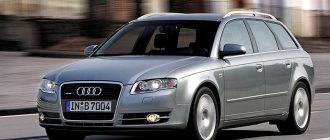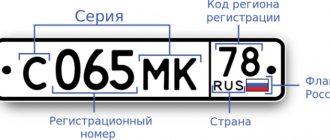Towing a vehicle with a flexible hitch
Towing a car with a flexible hitch is the most common method of towing passenger cars.
A flexible hitch, which is usually a fabric cable, is present in the trunk of almost every car owner. And the point here is not that drivers care about the problems of possible towing. Usually the cable, along with a fire extinguisher, a warning triangle and a first aid kit, is included in the motorist’s kit, so it willy-nilly ends up in almost any trunk.
An example of towing with a flexible hitch is shown in the following picture:
In practice, in addition to the towing cable, special towing mounts will also be required. On some cars, the mounts are lugs that stick out from under the bumpers. On others, you should use a special loop that is screwed into the mount under the plug in the bumper.
It is with a flexible hitch that category B cars are most often towed.
Transporting a vehicle on a rigid hitch
Unlike the cable, which every motorist has in their kit, a rigid coupling is a rare attribute. It is most often used by tow trucks. But towing with a rigid hitch requires the same additional equipment: a warning triangle, a first aid kit and a fire extinguisher. In this case, the cable may sag until the road surface is covered. The coupling device itself can have different designs. For example, the simplest ones involve one attachment point to each of the machines. Basically, a rigid coupling for passenger cars has this design. More complex hitches have several points and allow the vehicle to be towed exactly along the same track as the tractor, without the slightest shift to the sides. Each type of device has different towing rules. Towing on a rigid device allows you to move heavy vehicles.
What should it be
What is necessary for successful and authorized transportation of a vehicle by towing:
- Serviceability of brake and steering systems.
- Integrity of the body covering - there should be no breaks or pointed pieces bent outward (if the car has been in an accident).
- Serviceability of door hinges, handles, glass.
- Carabiners and other elements of the connecting device must be in good working order.
- A flexible clutch requires a certain length of cable.
- For rigid fastening - a special device made of durable and high-quality metal.
When transporting a passenger car, a flexible hitch option is suitable. But to transport a truck or passenger vehicle, a rigid hitch is required.
With the latter type of towing, the trajectory of the second vehicle will not deviate. Thus, during travel there will be no unnecessary interference for other participants.
Rope length
The cable should not be shorter than 4 meters and longer than 5 meters. It should be taken into account that the longer the flexible clutch equipment is, the greater the risk of deviation of the trajectory when moving.
If the cable is shorter than the specified norm, then there is a high risk of a collision between the driven vehicle and the vehicle pulling it.
The color of the cable does not matter. The accumulation of steel fibers is impregnated with reflective compounds.
In the case of using a red and white cable with a “reflector” effect, it is allowed not to attach striped signs. Such cables themselves signal and serve as a means of issuing warning signals.
Most often you can find products made from threads of the following shades and their combinations:
- red;
- orange;
- blue;
- blue and white;
- white with red;
- orange and white;
- other variations.
Speed also plays a role in the presence of a particular length of cable. Even driving slowly by the lead driver will not allow the trailing motorist to drive perfectly smoothly.
This is why it is required that the second (transported) car be driven by a person who is always ready to correct the motion vector in a timely manner.
Travel speed
The main postulate of the Rules regarding the speed limit applies to almost all types of vehicles and in all cases of towing. One rule applies to everyone.
Permitted speeds when towing another vehicle:
| within the boundaries of the village | no more than 50 km/h |
| outside the city, town, along the highway | no higher than 40 km/h |
| in case of independent movement of the coupled car | no more than 80 km/h |
| with attached trailer | no more than 70 km/h |
If a car has an automatic transmission and is subject to forced removal from its location on the roadway, then it must be driven exclusively at a speed of 30 km/h - no more.
The only thing is that if the number of gears is more than 3 stages, it is allowed to transport the vehicle at an increased speed, but not more than 50 km/h.
Rules for cars and trucks
The method of transporting a car using a rigid structure must comply with certain conditions. They vary slightly depending on the type of vehicle being moved.
Are common
Rigid coupling makes the following rules mandatory:
- the driver must sit behind the wheel of the driven vehicle, except in cases where the device gives him the opportunity to drive along the trajectory of the leading vehicle when moving in a straight line;
- if a bus or trolleybus is towed, no passengers are left in it;
- when moving the truck, there should also be no people in the back;
- a rigid hitch for passenger cars is also used when there are passengers in the cabin;
- vehicle speed cannot be higher than 50 km/h;
- the structure itself must be brightly colored so that other road users can see it and not try to wedge themselves between the leading and driven vehicles;
- The vehicle being towed must have its hazard lights turned on or a sign posted.
More on AutoLex.Net:
Basic questions about car electrical equipment: basic electrical equipment, operating diagram, installation of additional systems
If the car's steering does not work, this method cannot be used. And in case of damaged brakes, a rigid structure is allowed for use. But the mass of the towed vehicle must be less than the driving one. You can only drag one car, no more.
Distance
The distance between the towed person and the tow vehicle should be sufficient, but not too large. The distance on a rigid coupling is allowed up to 4 m. This is what makes movement safe. The driver of the leading car can see the road from the sides and behind in the mirrors. The one who sits behind the wheel of the follower retains the opportunity to stop in time and not collide with the vehicle in front. The road train does not block the road.
Length
The size of the device is selected in accordance with the requirement for the distance between vehicles. Since it cannot be more than 4 m, the length of the rigid coupling must also be less than this value. The total size of the base of the structure and the fastenings with which it clings to cars are taken into account.
Driver behavior
The traffic rules do not contain nuances that are necessary for successful towing. But experienced motorists know and use them:
- the route is chosen in advance;
- it should not have many problem areas (intersections, U-turns, highways, etc.);
- if it is a rigid hitch for trucks, it is better to drive at a speed of up to 40 km/h;
- you need to agree in advance what signals to communicate on the road if you need to stop and take other actions;
- no need to make sharp turns with the steering wheel;
- movement and maneuvers must be performed smoothly, especially acceleration and braking;
- It’s better not to use backward driving, and if you can’t do without it, then do it in concert.
It should also be taken into account that a rigid hitch is undesirable when you need to pull a car with an automatic gearbox. The equipment may develop additional malfunctions during the process. The likelihood of damage is even higher when using a car with an automatic transmission as a tow vehicle.
More on AutoLex.Net:
Complete computer diagnostics of a car: what will show whether you can do it yourself
To learn how to properly tow a vehicle with a rigid hitch, watch this video:
Features of a rigid coupling
This method of towing is carried out using a solid structure, one end of which is attached to the driving vehicle, the other to the driven one. It allows both vehicles to be kept on the same line while driving, which ensures reliability and safety.
Therefore, a rigid vehicle coupling is especially useful for moving heavy, clumsy equipment. It will prevent cars from colliding with each other.
Advantages of a rigid hitch
Compared to a flexible coupling, a rigid one has a lot of undeniable advantages. Firstly, there is no jerk, and the transported vehicle will not be able to approach the tractor at a dangerous distance. Secondly, there will always be a given distance between two cars. Thirdly, a rigid coupling requires the participation of only one driver in the towing procedure (at the wheel of the tractor), whose qualification level is subject to low requirements. And most importantly, this type of transportation is considered as safe as possible. It is these advantages that make it possible to use the rigid type of towing everywhere: in adverse weather and road conditions, in heavy traffic and any malfunctions.
Inventions
Mercedes-Benz has invented an electronic collar for trailers. The new system is called Trailer Stability Assist (TSA). It is fully integrated into the vehicle's existing electronic stability control system. TSA quickly detects the beginning of a skid or lateral sway of the trailer and effectively suppresses these movements by alternately braking the right and left front wheels of the vehicle.
Not all drivers are familiar with the rules for towing vehicles: in driving schools little time is devoted to this section, and in practice, not many have tested themselves as a driver of a towing or towed vehicle.
In a real traffic situation, the lack of theoretical and practical knowledge causes certain difficulties.
Rules for towing with a rigid hitch
Towing a vehicle with a rigid hitch
First of all, traffic regulations prohibit towing in any case if the steering of the towed vehicle is faulty - it can only be transported by partial or full loading. Sometimes they write that when hitching with three attachment points, it is not necessary for the driver to be behind the wheel of the towed car - this is an erroneous idea that contradicts the requirements of the traffic rules.
The driver of the towing vehicle must have at least 2 years of driving experience. The dimensions of the rigid coupling must be such that the distance between the machines is no more than 4 meters. The weight of a towed vehicle with a non-working brake system should not exceed half the weight of the “tug”.
Towing with a rigid hitch
Unlike towing with a flexible hitch, in which the tow rope can sag to the ground, towing with a rigid hitch is carried out using special fixed devices, usually made of metal.
At the same time, towing couplings can be of various designs . The simplest rigid couplers have one attachment point for each vehicle. More complex ones have multiple attachment points to the towed vehicle (as in the picture above) and allow the towed vehicle to follow the path of the towed vehicle while driving in a straight line. The rules for different types of rigid couplings are different.
In practice, towing with a rigid hitch is used much less often than towing with a flexible one. However, rigid couplers have several advantages over flexible ones. For example, they are more durable and allow you to tow heavy trucks.
We recommend: DIY car window tinting
Rules for transportation on a rigid hitch
For towing with a rigid hitch, the traffic rules provide for certain conditions:
- All trailers, even those with additional brakes, must be towed using a rigid hitch. With a flexible hitch you will get to the first traffic police post, and there you will be given a fine.
- Towing a vehicle with faulty brakes or broken steering is permitted only with a rigid hitch.
- A car damaged in an accident is towed only with a rigid hitch.
- The coupling rod can be single or double.
- The hitch must be brightly colored or marked with signal flags.
- On a rigid coupling, the speed should not exceed 50 km/h.
- The car going first turns on the low beam, regardless of the time of day, the trailing car turns on the emergency flashing.
- Towing without a driver is prohibited. An exception will be a special towing design, which will help ensure that the driven car repeats any maneuvers of the leading one on a straight section of the track/highway.
- The towing distance on a rigid coupling between cars is no more than 4 meters .
Definition of the concept
Towing a car is the manipulation of transporting a car using the traction force of another vehicle and connecting parts. The principle of moving mechanical vehicles is simple - one machine transports another from one place to another.
The following concepts appear in the procedure:
- A towing vehicle is one to which a vehicle that requires forced transportation is attached.
- A towed car is one that is directly transported by a trailer (travels second, attached to the towing vehicle).
- A towbar is a special device at the bottom behind the car that allows it to be used as a tractor. Carabiners and other connecting elements cling to the tow bar.
- “Paws” (hooks, etc.) - are used in front of the car in order to hook the connecting device coming from the towing vehicle (from the towbar).
The towed vehicle must be suitable for stopping in time on the road or adjusting turns.
If the car is not capable of this, then it should be evacuated using special transport equipment. In this case, transporting a car with a broken steering wheel or brakes does not apply to towing.
Is a category necessary?
The driver of a car that is pulling another vehicle on an inflexible device must be quite experienced. But one of the issues that worries motorists in connection with the concept of “rigid coupling” is the category of rights. Some people think that they should be with the letter E, allowing them to carry a trailer heavier than 750 kg.
The definition of the difference between it and a car is in the traffic rules:
“Trailer” is a vehicle that is not equipped with an engine and is intended to be driven in conjunction with a power-driven vehicle.
A motor vehicle is a vehicle driven by an engine. the term also applies to any tractors and self-propelled machines.
Towing of cars is regulated by paragraph 20 of the traffic rules. It does not specify categories of rights. They are discussed in Article 25 of the Law “On Road Safety”. The legal document establishes a special category for each vehicle, as well as for the use of trailers with them. There is no mention of towing here.
It is clear from the traffic rules that a trailer and a car that has lost the ability to move under its own power are different types of vehicles. The law that exists for the use of the former does not apply to the latter. And in order to tow a car, the driver does not need to have the letter E on his license.
Government Decree No. 333 of March 24, 2017 contains a clarification regarding the length of service of a motorist:
When towing, driving towing vehicles must be carried out by drivers who have been licensed to drive vehicles for 2 years or more.










